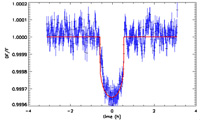CoRoT team announces detection of smallest exoplanet to date
3 February 2009
An exoplanet barely larger than the Earth has been discovered by the CoRoT satellite. This was announced on 3 February at a press conference during the First CoRoT International Symposium held in Paris. |
|
The dip in the light curve indicates the presence of a transiting object: CoRoT-Exo-7b |
The planet, CoRoT-Exo-7b, has a diameter less than twice that of Earth making this the smallest exoplanet radius measured yet. It orbits its parent star, (CoRoT-Exo-7: a main-sequence K-type star at a distance of 140pc) every 20 hours. The surface temperature is estimated to be of order 1000-1500°C.
Although the density of the planet has not yet been well determined preliminary indications are that it may be rocky and covered in liquid lava. An alternative proposal is that it may be a ‘sauna planet’ of half water (in a superheated state) and half rock.
This exoplanet was first seen by CoRoT last spring but a campaign of ground-based observations was needed to confirm its nature.
To date more than 330 exoplanets have been detected. Most of these are giant, gaseous planets. The discovery of CoRoT-Exo-7b is significant because recent measurements have indicated the existence of small-mass planets but their size has remained undetermined until now.
Related publication
The findings will appear in 'Transiting exoplanets from the CoRoT space mission VII. COROT-Exo-7b: The first super-earth with radius characterized' by A. Léger , D. Rouan , J. Schneider , R. Alonso , B. Samuel , E. Guenther , M. Deleuil , H.J. Deeg , M. Fridlund, et al. to be submitted to Astronomy and Astrophysics.

